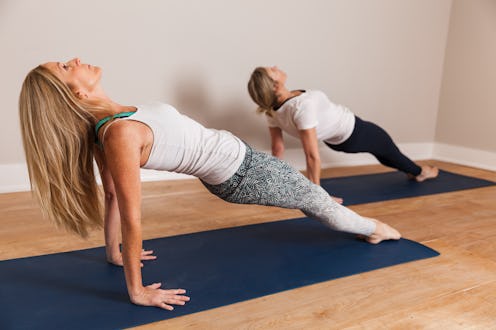Fitness
How To Do A Reverse Plank For Better Back Strength
You'll feel the burn in your entire backside.

If you can do a regular plank, it stands to reason you should be able to flip it over and reverse it. But the moment you attempt it, it becomes clear that reverse planks are a whole different ballgame.
Out of all the plank variations that exist, learning how to do a reverse plank is notoriously on the more difficult end of the spectrum. And that’s because the exercise activates the muscles throughout your entire body. “Unlike a traditional plank, reverse planks target your posterior muscles, aka the muscles along the backline of your body, including your lower back, glutes, hamstrings, and abdominals,” Paige Willis, RYT 200, a power vinyasa yoga teacher, tells Bustle. They also hit your arms, wrists, and legs in a way you might not be used to, while also opening the front of your body, says Willis.
Of course, the fact that this exercise is challenging is all the more reason to try it more often. When you do a reverse plank, you’re activating those under-used muscles (versus the anterior muscles, like the quads and lats), which helps to ensure your body stays balanced. “It's a solid counter exercise for people who give planks and push-ups a lot more love in their workout routine,” Willis says. “In this case, a reverse plank can help prevent muscle imbalances by shifting the focus of strength from your front body to your back body.”
Reverse planks can also help combat rounded shoulders, an all-too-common body ailment that happens when you’re hunched over a computer all day (and leads to poor posture and neck and shoulder pain). “Some people are extra-tight in their shoulders and struggle with the [reverse plank] stretch, and that’s why it’s beneficial to do,” says Sarah James, Pilates instructor and founder of Pilates by Sarah James. And since your hands are facing your feet in the reverse position, your wrists are also getting a great stretch. So, while the move is technically a strength exercise, the reverse plank doubles as a stretch, all while testing your stability as you hold your body in the position.
To get the most benefit from a reverse plank, try to hold it for 30 seconds and work your way up to one to two minutes. “If you want more after that, add in a few more reps at 30-second intervals,” Willis recommends. Just be easy on yourself in the process. “As with any exercise, you can't expect immediate results,” she adds. “If you incorporate the reverse plank into your workout regimen, you'll start to notice increased strength in your posterior muscles after a couple of weeks of consistency.” Read on for how to do it properly so you can reap the most benefits.
How To Do A Reverse Plank
Here’s how to do a perfect reverse plank, according to Willis.
- Sit on the floor with your legs extended out in front of you.
- Place your palms on the floor slightly behind your hips.
- Face your fingertips toward your feet.
- Press into your palms as you lift your lower body up toward the ceiling.
- Create a long, straight line from your heels all the way to the top of your head as you gaze up at the ceiling.
- If you can, point your toes.
- Squeeze your legs in toward each other for better balance.
- Remember to breathe as you hold for 30 seconds.
Willis notes that this pose requires a lot of strength from your arms and wrists, so if you feel pain or discomfort in those areas, modify by lowering onto your elbows for a reverse forearm plank.
Studies referenced:
Ko, M. (2018). Comparison of the effects of different core exercise on muscle activity and thickness in healthy young adults. Physical Therapy Rehabilitation Science. https://doi.org/10.14474/ptrs.2018.7.2.72
Experts:
Paige Willis, RYT 200, power vinyasa yoga teacher
Sarah James, Pilates instructor and founder of Pilates by Sarah James